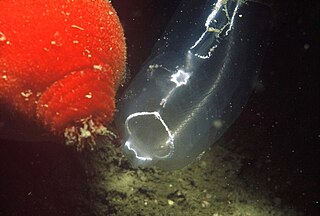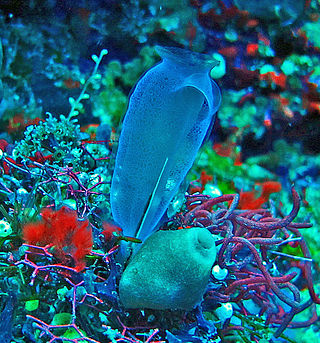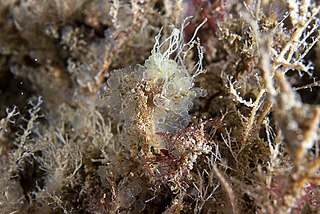
Clavelinidae is a family of tunicates in the order Aplousobranchia. It describes a group of marine animals.

Diazonidae is a family of sea squirts belonging to the order Aplousobranchia.

Clavelina sabbadini is a species of tunicate, in the genus Clavelina. Like all ascidians, these sessile animals are filter feeders.

Nephtheis fascicularis, commonly called the lollipop tunicate, lollipop coral, or blue palm coral, is a species of tunicate that is native to the shallow reefs of Indonesia. It is the only species in its genus Nephtheis. They are not photosynthetic, and live on plankton and small organic particles obtained from the water currents. The branched stems are formed by tiny polyps called zooids.

Phallusia is a genus of tunicates of the family Ascidiidae, which includes the following species:

Rhopalaea crassa, sometimes called the blue ascidian, is a species of tunicate in the family Diazonidae. It can reach a length of five centimetres and lives in the Indo-West Pacific.

Diazona is a genus of tunicates in the family Diazonidae.
Arnbackia is a genus of ascidian tunicates in the family Styelidae. The only species is Arnbackia novaezelandiae.
Berillia is a genus of ascidian tunicates in the family Styelidae. The only species is Berillia boltenioides.
Dextrocarpa is a genus of ascidian tunicates in the family Styelidae.
Kukenthalia is a genus of ascidian tunicates in the family Styelidae.
Oligocarpa is a genus of ascidian tunicates in the family Styelidae.
Podostyela is a genus of ascidian tunicates in the family Styelidae. The only species is Podostyela grynfeltti.
Syncarpa is a genus of ascidian tunicates in the family Styelidae.
Theodorella is a genus of ascidian tunicates in the family Styelidae.
Anomopera is a genus of ascidian tunicates in the family Molgulidae. Anomopera ingolfiana is the only described species of Anomopera.
Namiella is a genus of ascidian tunicates in the family Molgulidae. The only species is Namiella bistigmata.
Protomolgula is a genus of ascidian tunicates in the family Molgulidae.
Bathypyura is a genus of ascidian tunicates in the family Pyuridae.

Perophora listeri is a species of colonial sea squirt in the genus Perophora, native to the North Atlantic.







